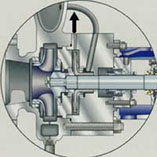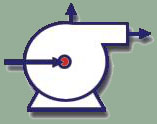 "Multiplicity ought not to be posited without necessity." — Occam's Razor Otherwise stated: |
Process Diagrams
Single pump systemWhen a single pump is selected for reflux plus product flows at the higher product head, the higher head to the reflux stream is throttled. This wastes energy. When single pump is selected for reboil plus bottoms flows at the higher bottoms head, the higher head to the reboiler stream is throttled. This wastes energy. Reference Fig 2a full size pump (performance curve) example. Applicable for API pump types OH2 and OH3. Two pump system: Complex, high capitalSeparate pumps are selected for each service. Suitable pump selections for product and bottoms flows less than 60 GPM are frequently not practical. (See Pumps and Systems Magazine article, Low Flow Options.) This leads to oversizing the reflux and reboil pumps for higher head. Applicable for API pump types OH2 and OH3. Booster pump applicationsThe reflux pump is selected for reflux plus product flows. A smaller booster pump increases head for the product flow. The reboil pump is selected for reboil plus bottoms flows. A smaller booster pump increases head for the bottoms flow. These arrangements allow the larger reflux and reboil pumps to be more ecomonically sized for 1800 RPM when the NPSHA does not allow for suitable 3600 RPM main pump selections. When the NPSHA allows use of a 3600 rpm primary pump, the separate low-flow, high-head booster pump can be replaced by incorporating the Split Flow feature into the primary pump. Reference Fig 3a Split Flow pump (performance curve) example. Applicable for API pump types OH2 and OH3. Dual Service: The Split Flow SolutionDual-Service pump installations are similar to those shown in Figure 3 except the product pump impeller and the reflux pump impeller are in the same pump casing. The bottoms pump impeller and the reboil pump impeller are also in the same pump casing. Standard pumps are modified to incorporate the auxiliary low-flow impellers, which are selected to fit the hydraulic requirements of the low-flow, high-head slipstreams. These arrangements reduce the number of pumps — saving space, motor power, and installation costs. Reference Fig 2a Split Flow pump (performance curve) example. Applicable for API pump types OH2 and OH3. See article in Hydrocarbon Processing for another diagram of the Split Flow application. Feeding separate towers
Option 1This option uses two pairs of different size and type pumps selected for the individual tower requirements. This compares with the Figure 1 arrangement and is less favorable than Option 2 due to space limitations and higher capital cost. Option 2This option uses a pair of larger pumps feeding both towers. Flow to the lower pressure tower is throttled. This wastes energy and compares with the Figure 2 arrangement. Option 3This option uses a pair of dual-service pumps feeding both towers. The first stage impeller is selected for the total flow of the towers and the second stage impeller increases the head of the lower design flow for the higher-pressure tower. The pumping energy required is comparable to Option 1. The dual-service Big Split Flow pump option saves significant energy compared with Option 2 and compares with the Figure 4 arrangement. Reference Fig. 5a performance curves comparing full size pump with Split Flow pump. Applicable for API pump types BB2 and BB3. |
Process DiagramsDual Service: The Split Flow Solution Also see diagram in Hydrocarbon Processing “The obvious often escapes us.”
|



